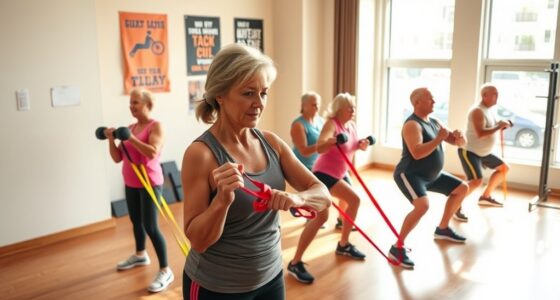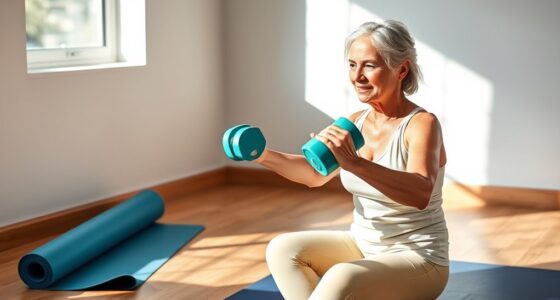Dumbbell workouts are a simple and effective way for seniors to build strength at home. These exercises boost muscle strength, improve balance, and enhance cognitive function. Focus on essential moves like bicep curls and chest presses, using light weights for safety. Remember to warm up, maintain proper form, and stay hydrated. Setting realistic goals and joining a supportive fitness community can keep you motivated. There’s so much more to explore about maximizing your fitness journey!
Key Takeaways
- Dumbbell workouts for seniors enhance muscle strength, balance, and coordination, crucial for preventing falls and injuries at home.
- Essential exercises include bicep curls, chest presses, and side leg raises, all manageable with light weights (1-5 pounds).
- Prioritize proper form and warm-up for at least 5 minutes to ensure safe and effective workouts.
- Aim for at least two days of strength training per week, incorporating flexibility and balance exercises for overall fitness.
- Set realistic goals and establish a consistent workout schedule to stay motivated and track your progress at home.
Benefits of Dumbbell Workouts for Seniors

When you incorporate dumbbell workouts into your routine, you can enjoy a myriad of benefits that greatly enhance your overall health.
For seniors, these exercises can considerably boost muscle strength, helping to combat age-related muscle loss known as sarcopenia. By improving your range of motion, dumbbell workouts also enhance balance and coordination, which reduces the risk of falls—one of the leading causes of injury among older adults. Additionally, maintaining consistent self-care routines can further support your physical well-being. Engaging in regular strength training also helps protect energy levels, enabling you to better manage daily challenges. It is essential to understand that environmental interactions play a role in overall development, and staying active contributes positively to your physical health. Furthermore, many seniors are discovering the joy of texting humor, which can also brighten their spirits while engaging in physical activities.
Regular strength training can improve bone density, lowering the chances of osteoporosis and fractures. You’ll find that daily tasks become easier, promoting independence.
Plus, strength training has been linked to better mental health, reducing symptoms of depression and anxiety and ultimately contributing to a higher quality of life. Furthermore, engaging in physical activity like strength training can also lead to improved cognitive function, akin to the benefits of listening to classical music.
Essential Dumbbell Exercises for Strength Building

Incorporating dumbbell exercises into your routine not only strengthens your body but also enhances your overall functional fitness. Essential movements like bicep curls and chest presses build upper body strength, while side leg raises boost stability and mobility. Using light dumbbells, ranging from 1 to 5 pounds, allows you to enhance muscle strength without straining your joints, making this a safe choice for older adults. Regular exercise can also help improve your credit score, as financial health often correlates with overall well-being. Additionally, engaging in regular physical activity can significantly contribute to your cardiovascular health, which is crucial as we age. Incorporating exercises that improve muscle strength can further enhance your ability to perform daily activities.
Research shows that maintaining muscle strength can reduce the risk of falls among seniors, which is essential for maintaining independence. Don’t forget to include exercises targeting both upper and lower body, such as back pulls and hamstring curls, to maintain balance and overall fitness. Regularly engaging in short, manageable sessions, like 10-minute routines, can encourage consistency and make strength training accessible, improving your bone density and reducing fall risks in daily activities. Additionally, incorporating high-protein breakfasts can support muscle recovery and energy levels for your workouts.
Tips for Safe and Effective Workouts

To guarantee safe and effective workouts, it’s essential to prioritize proper form from the very beginning. Start with light weights and focus on controlled movements to avoid injury while engaging your muscles effectively. Regular monitoring of air quality in your workout environment can also enhance your overall safety and comfort during exercise. Additionally, maintaining a growth mindset can help you stay motivated and open to adapting your fitness routine as needed. Engaging in regular physical activity can also improve cognitive function in older adults, which is essential for overall well-being. Incorporating financial considerations for any fitness-related expenses can also help ensure that your workout routine is sustainable.
Prioritize proper form and start with light weights to ensure safe and effective workouts while engaging your muscles.
If you have balance concerns, incorporate seated modifications for greater stability and reduced fall risk.
Always warm up for at least 5 minutes to prepare your muscles and joints, minimizing the chance of strains or sprains. Allow for adequate rest periods between exercises and workouts to support recovery, especially since older adults may need more time to recuperate.
Stay hydrated, listen to your body, and feel free to take breaks or adjust workout intensity to match your individual fitness levels and capabilities. Additionally, incorporating advanced technology in your workout routine can enhance overall performance and safety.
Creating a Balanced Routine

Creating a balanced workout routine is essential for enhancing your strength and overall functionality as you age. Aim to include strength training exercises at least two days a week, focusing on major muscle groups. Don’t forget to add flexibility and balance exercises, which help reduce fall risks. Regular exercise can also prevent feelings of running dry, enhancing both physical and mental health. Additionally, incorporating regular dental check-ups into your health routine can contribute to your overall well-being. Engaging in educational toys can provide cognitive benefits that complement physical exercise by stimulating mental agility. Furthermore, using toys designed for imaginative play can enhance cognitive development and creativity, which are important aspects of maintaining mental agility as you age. It’s also beneficial to create a retirement savings plan to ensure financial stability as you continue to invest in your health.
| Exercise Type | Examples |
|---|---|
| Strength Training | Dumbbell curls, squats |
| Flexibility | Stretching, yoga poses |
| Balance | Standing leg lifts, heel-to-toe |
| Frequency | 10-30 minutes, most days |
Using light dumbbells or resistance bands can effectively improve your strength while allowing modifications. Prioritize proper form to prevent injury, starting with lighter weights and gradually increasing as you progress.
Staying Motivated and Consistent in Your Fitness Journey

Staying motivated in your fitness journey can feel challenging at times, but setting realistic and achievable goals makes a significant difference. These goals provide clear milestones to track your progress. Additionally, utilizing online deals and coupon codes can help you find affordable workout equipment, enhancing your routine without breaking the bank.
To keep things fresh, incorporate a variety of exercises, like dumbbell workouts, to prevent boredom and enhance your strength. Establishing a consistent workout schedule reinforces your commitment—dedicate a specific time each day for exercise. Practicing mindfulness techniques can help block internal chatter, allowing you to focus better during your workouts. Moreover, embracing innovation in fitness can lead to discovering new methods and tools that can enhance your experience.
Consider joining a fitness community or finding a workout buddy; having social support makes staying motivated easier. Ultimately, celebrate small accomplishments, whether it’s completing a workout or lifting heavier weights. Incorporating mindfulness practices into your routine can also enhance your focus and motivation.
These victories boost your confidence and encourage you to continue pushing forward in your fitness journey. Stay consistent, and you’ll see progress!
Frequently Asked Questions
What Is a Good Dumbbell Weight for Seniors?
A good dumbbell weight for you typically ranges from 1 to 5 pounds. This allows you to perform exercises safely while still feeling challenged.
Aim for a weight that lets you lift for 10 to 15 repetitions with proper form. As you get stronger, consider adjustable dumbbells to gradually increase your weight.
It’s wise to consult with a healthcare professional or fitness trainer to find the right weight for your fitness level and health conditions.
How Many Times a Week Should a 70 Year Old Lift Weights?
You should aim to lift weights at least 2 to 3 times a week to maintain your muscle mass and strength.
Each session needs to target all major muscle groups for balanced development.
Start with light weights to focus on proper form, gradually increasing as you gain confidence.
Incorporating a variety of exercises will enhance your overall physical function and help reduce the risk of falls.
Always consult a healthcare provider before starting your program.
What Is the Best Weight Lifting Routine for Seniors?
The best weight lifting routine for you should target all major muscle groups, focusing on the upper body, lower body, and core.
Start with light weights, around 1 to 5 pounds, and gradually increase as you gain strength. Aim for resistance training at least twice a week, ensuring you maintain proper form to avoid injury.
Don’t forget to include warm-ups and cool-downs to improve flexibility and enhance your overall workout effectiveness!
Can You Build Strength With Just Dumbbells?
Isn’t it amazing how something as simple as a dumbbell can transform your strength? Yes, you can absolutely build strength with just dumbbells.
They’re versatile tools that engage multiple muscle groups effectively. By starting with lighter weights and gradually increasing resistance, you’ll see improvements in muscle strength and endurance.
Plus, dumbbells can be modified to fit your fitness level, making them perfect for anyone looking to enhance their strength and overall well-being.
Conclusion
Incorporating dumbbell workouts into your routine can truly enhance your strength and overall well-being. Remember, “slow and steady wins the race.” By focusing on essential exercises, practicing safety, and staying consistent, you’ll not only build muscle but also boost your confidence. Embrace this journey, and don’t hesitate to adjust your routine to fit your needs. With dedication, you can enjoy the countless benefits of staying fit and active at home. Keep pushing forward!










